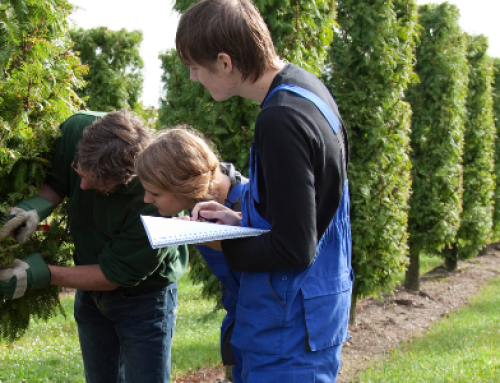Jobs and Skills Australia have released a capacity study on Australia’s clean energy workforce needs, titled The Clean Energy Generation: workforce needs for a net zero economy.
Apprenticeships are highlighted throughout the report as a main pathway into the clean energy workforce, which need to be a focus of governments and industry when considering how Australia will reach net zero.
“Fundamentally, this study highlights the need to increase the number of apprenticeships across the most relevant trades: Electro-Technology and Electrical Distribution and Transmission.” page 238
The 285-page report picks up on feedback and suggestions from a wide range of apprenticeship stakeholders. This blog post takes a look at several of the key themes related to apprenticeships.
Defining the clean energy workforce
This report recognises that every segment of the economy will be impacted in some way. However, there will be an increasing demand for workers with the skills and experience needed to thrive in the core industries that make up the clean energy workforce.
“Reaching the Australian Government’s net-zero emissions target by 2050 will require a workforce transformation that is substantial but not unprecedented.” page 7
The main clean energy industries fall into the following categories, with each expected to grow over the coming decades:
- Energy supply: Generation, transmission and distribution of clean energy across Australia. This includes electrical distribution trades workers alongside a range of other trades workers.
- Energy demand: Activities around energy use and efficiency. This will include electricians and other electrical workers, other trades workers, but also professional workers across a range of disciplines.
- Energy enabling: Services such as research, training, regulation, engineering, procurement, and supply chains; this category are the workers across trades and professions who enable clean energy projects.
- Carbon lifecycle: Carbon capture and circular economy, along with other activities and services that reduce or eliminate carbon from the environment.
There are two industry areas where the workforce is expected to reduce or transform. Workers in these industries may already have the skills to move into the clean energy workforce, but may need assistance to do so.
- Emission-intensive sectors: High energy use sectors such as food and paper manufacturing, metal and cement manufacturing, and other industries with high emissions outputs either through energy use or as a direct output of the manufacturing process.
- Transitioning: Sectors such as coal mining, oil and gas exploration, and fuel retailing; impacts will also be felt amongst communities and supply chains.
Clean energy occupations
The Clean Energy Generation report lists 38 occupations that are critical to the clean energy workforce (page 10). Of these, 16 are trades roles which are trained through apprenticeships, and 1 is a labourer role which can be trained through a traineeship in many of the states and territories. Others are professional roles which are typically trained through a university pathway, and manager roles which may have pathways from trades work.
Pathways into clean energy apprenticeships
The Clean Energy Generation report makes it clear that Australia will need an increasing large number of qualified trades workers. To fill these roles, we need a strong apprenticeships system and more young people taking up trade apprenticeships.
To achieve the number of apprentices and qualified trades workers needed, it is vital that we improve diversity. This means attracting more women, people with disability, regional and remote workers, and other underrepresented cohorts.
For many school students, the transition into post-school education or employment is relatively easy. For many others this transition poses challenges which require ‘supported entry pathways’. Supported entry pathways into trades include school-based apprenticeships for current school students, pre-apprenticeships and other lower-level vocational courses.
These pathways are not just positive for young people facing challenges, they also provide an opportunity for people to try out different career options before choosing the best match for themselves. Groups who are traditionally underrepresented in trades will often find supported entry pathways to be a good mechanism to support their transition into a trade apprenticeship.
“Early school leavers often take pre-apprenticeship pathways to bridge gaps in their studies. Pre-apprentices are also slightly more likely to be female (5.0% vs 3.2%) and have a disability (5.5% vs 2.5%).” page 128
There has been strong growth in some supported entry pathways, such as the Certificate II in Electrotechnology, the pre-apprenticeship to become an electrical apprentice. Other pathways, such as school-based apprenticeships, show signs of underutilisation.
“Only around 2,300 students commenced a school-based apprenticeship in clean energy relevant training packages in 2022.” page 128
School subject selection, beyond school-based apprenticeships, are also a challenge facing the future clean energy workforce. STEM subjects are important for students planning to study or work across a range of trade and professional clean energy roles. However, participation in STEM subjects has been declining and uptake is particularly low amongst diverse cohorts.
“Lower participation in STEM fields of education is more profound amongst diverse groups… Trade apprenticeships had even lower female representation — only 5.6% of electrical apprenticeship commencements were female in 2021.” page 127
There is a lack of awareness from school students that clean energy roles will typically require STEM skills, with three quarters of young people globally aspiring to ‘green jobs’ but 60% of Australian students reporting that STEM isn’t related to their desired career (page 127).
Sharing the responsibility
Building the clean energy workforce that is needed in Australia is a responsibility that must be shared by governments, industry, employers, and education institutions.
The vocational education and training (VET) sector and higher education providers including universities are increasingly working together to bridge the gap between sectors. This enables learners to acquire skills across both forms of education that are relevant for the clean energy workforce.
When combined with an employment arrangement though a degree apprenticeship, this shared responsibility of training enables learners to gain skills and experiences that will fill skills gaps in clean energy workforce.
“Some of Australia’s dual-sector universities are already looking to bridge the gap between the two distinct sectors through initiatives like degree apprenticeships.” page 104
When considering apprenticeship and degree apprenticeship pathways into the clean energy workforce, the role of government is often one of enabling employers and education providers. In the case of degree apprenticeships, governments are working to create an environment where degree apprenticeships are made available, are appropriately funded, and other support mechanisms including incentives are implemented.
“However, given the newness of some roles, targeted incentives also need to be flexible enough to cater to a wide range of changing, emerging needs.” page 221
Government, through organisations such as Jobs and Skills Australia, also play a significant role in identifying new roles and providing support for employers to train staff including apprentices in these emerging roles.
The New Energy Apprenticeships incentives currently target trade apprenticeship roles, supporting apprentices into their apprenticeship and through to completion. Currently these incentives are only available for existing roles, as are employer incentives. The Clean energy generation report suggests that governments should consider mechanisms to broaden incentives criteria to allow for emerging roles.
Availability of training and electives
The availability of training is a challenge for many apprentices and employers, for many different reasons.
The physical location of both work and training can be a significant challenge across regional and remote Australia, where a lot of clean energy work occurs. While finding potential apprentices is one issue that employers in these regions face, fly-in-fly-out options may not be suitable for an apprenticeship arrangement.
“In some instances, this requires short-term moves or fly-in-fly-out work, which can be inaccessible for apprentices, particularly in their first year. Working in remote areas is also impractical for apprentices who need to access in-class training or other work sites to gain all of their competencies.” page 209
The availability of specialist training stretches into metropolitan areas as well as regional and remote, when there are a small number of training providers offering elective units, or even in some cases a small number of providers offering qualifications. Partnerships between training providers, and between training providers and industry, can help overcome some of these challenges, particularly as the clean energy workforce expands.
“Several training package electives are already available for electrical apprentices to gain skills in areas like solar and battery installation during their apprenticeship. However, the availability of these electives is not always widespread, particularly for emerging technologies.” page 112
There can also be challenges in upskilling qualified workers when a qualification is not suitable as an entry-level apprenticeship. There are several Certificate IV, Diploma and Advanced Diploma qualifications for trade-qualified workers. The lengthy duration of these qualifications can be a barrier to many workers, however can be a useful method of transitioning to the clean energy workforce for workers in declining industries.
Who are the employers?
Apprenticeships are reliant on employers as well as on training providers and government. Employers provide the on-the-job training and skills development for apprentices. Governments, private sector employers, and Group Training Organisations (GTOs) are all active in hiring and supporting clean energy apprentices.
“The vast majority of trade apprentices in clean energy are now employed by the private sector. This has changed over time, as the number of clean energy apprentices employed by government enterprises has declined.” page 110
Over time, there has been a shift towards private sector employers taking on clean energy trade apprenticeships, as government and government business enterprises have seen declines in their share of apprentices. Private sector employers who take on clean energy apprentices tend to be very large businesses. Small employers are active as well, particularly in the electrical services industries.
There are additional challenges for employers taking on clean energy apprentices that other sectors may not face. Many clean energy roles are emerging, meaning that the training for these apprentices does not exist yet and employers are unable to access support for apprenticeships. Clean energy is also a large industry with many employers working in niche roles, making it difficult to give an apprentice the full range of experiences needed for an apprenticeship.
“Apprenticeships can only take place if employers are familiar and willing to engage with the VET system. There is a risk that employers in the clean energy sector may not be fully engaging with the VET system due to their lack of familiarity with it.” page 211
On top of these challenges, many employers in the clean energy sector are unfamiliar with the VET system and apprenticeships. Apprenticeships can be complex, making them daunting to employers who are unfamiliar with the systems and requirements in place.
International students as electrical apprentices
While the Clean energy generation report has a range of recommendations related to apprenticeships and increasing the supply of clean energy workers, it also makes the case that changing the availability of apprenticeships for migrants could work hand in hand with other measures.
The current Australian Apprenticeships system has strict eligibility criteria that mean most migrants, including international students, are unable to undertake an apprenticeship. However, there are skilled visa pathways for many trade occupations once someone is qualified or experienced.
In roles such as licensed trades, including electrical, there was a call from some stakeholders to open up apprenticeship placements to international students so they could be trained against Australian standards and with Australian experience.
“Given the impact that international education has had on Australia’s labour market and higher education sector, it is certainly an area that could be explored to fill existing skills gaps for clean energy occupations.” page 129
The report acknowledges the significant changes that would need to be made to create an environment where this could occur: changes to the visa system; pathways for apprentices to remain in Australia; a supportive environment for employers to take on international apprentices.
There are significant barriers for anyone coming to Australia on a student visa to undertake an apprenticeship: finding an employer and RTO sponsor; low wages during the apprenticeship; pathways to permanent residency.
Additionally, apprentices and international students are both vulnerable cohorts, so we would need to ensure high levels of support and regulation to avoid issues with international apprentices such as worker exploitation.
Recommendations related to apprenticeships
Throughout the Clean energy generation report there are recommendations related to apprenticeships. Chapter 9 of the report, starting from page 255, outlines the findings and opportunities that are discussed in detail in the preceding chapters.
Each of the below recommendations can be found in both their relevant chapter and in chapter 9, which is the page number given here.
- 4.1: Jobs and Skills Councils should explore options for dual-trade apprenticeship pathways. page 262
- 4.2: Explore funding, incentives and supports for dual-trade and degree apprenticeships in clean energy. page 262
- 4.5: Governments should explore the possibility of allowing international students to undertake apprenticeships, particularly in electrical trades. page 262
- 7.2: In collaboration with the states, consider how integrated trade and degree apprenticeships and higher apprenticeships could be implemented. page 265
- 7.7: Explore the merits of increasing group training apprentices in clean energy roles. page 265
- 7.10: Training providers should consider how to increase supported pathways (e.g. pre-apprenticeships) to help more disadvantaged and underrepresented students into training. page 265
- 7.18: Explore how incentives could be expanded to include employers who commit to supporting their apprentices in clean energy electives when the employer doesn’t work in the clean energy sector. page 265
- 8.8: Establishment of reporting mechanisms for large firms to report their apprenticeship numbers and ratio to total employees. page 269






